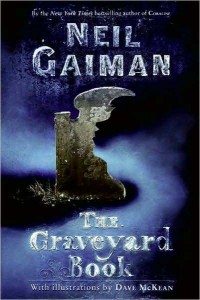 Neil Gaiman has long been a favorite writer of mine, going back to The Sandman. And, because his work is often published in limited editions, he feeds not only a reading love but also a bibliophilic one. I certainly enjoyed his last novel, The Graveyard Book (HarperCollins, 2008), and have several different editions. One aspect of that novel to me as a writer was its structure: a novel told through short stories, a form in which I’m particularly interested (this form is also called a mosaic novel, although that term is sometimes used more specifically). Some questions I’ve decided to investigate: How did Gaiman keep the structure unified? How did he interconnect the stories but give them enough substance that they might be read complete in themselves? And, on a tangentially related note, how did he handle point of view? Warning: Spoilers to follow.
Neil Gaiman has long been a favorite writer of mine, going back to The Sandman. And, because his work is often published in limited editions, he feeds not only a reading love but also a bibliophilic one. I certainly enjoyed his last novel, The Graveyard Book (HarperCollins, 2008), and have several different editions. One aspect of that novel to me as a writer was its structure: a novel told through short stories, a form in which I’m particularly interested (this form is also called a mosaic novel, although that term is sometimes used more specifically). Some questions I’ve decided to investigate: How did Gaiman keep the structure unified? How did he interconnect the stories but give them enough substance that they might be read complete in themselves? And, on a tangentially related note, how did he handle point of view? Warning: Spoilers to follow.
To begin, Gaiman keeps the novel structured in any number of conventional ways. Nobody “Bod” Owens is the protagonist and the central (but not only) point-of-view character; the book is about his growing up, and so he is at the center of every chapter/story. The same supporting characters recur in most if not all of the chapters—Silas the (unspoken) vampire; Bod’s adoptive parents, Mr. and Mrs. Owens; the witch Liza Hempstock; Mother Slaughter; Josiah; Lady on the Grey; etc. Some characters appear early and return late, like Scarlett (chapter two and chapter seven) and Miss Lupescu (chapter three, chapter seven, occasionally seen in between but usually in no more than a brief mention or visit). The antagonist, the man Jack, appears periodically throughout the novel, including an Interlude devoted to him. When Mr. Jay Frost makes friends with Scarlett in chapter seven, I knew immediately he was the man Jack; I wondered if Gaiman intended for Mr. Frost’s disguise to be so easily pierced by the reader, or was I just overly attuned to the pun of “Jack Frost”?
As I mentioned above, Bod is the central point-of-view character, but he is not the only one. When Scarlett appears (both early and late), Gaiman gives us several scenes from her point of view. Except when he shifts in chapter seven to show us some of what Silas is doing while he’s away from the graveyard, the only substantial shifts in point of view are to Scarlett. Not only does Gaiman give us separate (non-Bod) scenes from Scarlett’s point of view, he also switches to her point of view during scenes that are predominantly Bod’s point of view, as presented below with my annotations:
[Bod’s point of view] Bod bent down, took the objects from the altar stone, put them in Jack’s open gloved hand. Jack grinned.
“Scarlett. I am going to release you. When I take the knife away, I want you to lie, facedown, on the ground, with your hands behind your head. Move or try anything, and I will kill you painfully. Do you understand?”
[Shift to Scarlett’s point of view] She gulped. Her mouth was dry, but she took one shaky step forward. Her right arm, which had been twisted up to the small of her back, was now numb, and she felt only pins and needles in her shoulder. She lay down, her cheek resting on the packed earth.
We are dead, she thought, and it was not even tinged with emotion. (281)
Gaiman also makes this shift with some of the Jacks during the same chapter. While I understand the convention of a singular point of view inside a story, I’m afraid I’m at a loss to adequately explain why that convention is so important. When Gaiman—or, to refer to another favorite author, Charles de Lint—shifts point of view, I don’t feel as a reader discombobulated, or as if the narrative is somehow unintentionally fractured. What am I missing, I wonder?
While Gaiman keeps the novel’s structure unified through several conventional means, how does he also manage to let each story stand as its own separate narrative yet still remain interconnected with the others? Each chapter deals with a singular event in Bod’s life, set at two-year intervals:
How Nobody Came to the Graveyard describes the murder of his family and how Nobody ends up in the graveyard, and thus protected from the man Jack
The New Friend, when Bod meets Scarlett and the Sleer
The Hounds of God, when Bod meets Miss Lupescu and learns about ghoul-gates
The Witch’s Headstone, when Bod meets Liza Hempstock, tries to buy her a headstone, and is almost revealed to the man Jack
Danse Macabre, in which Bod takes part in an ancient ritual where the dead dance with the living (the living promptly forget, and the dead won’t speak of it)
INTERLUDE: The Convocation, where we learn that the man Jack’s murder of Bod’s family was not random
Nobody Owens’ School Days, wherein Bod goes to school and stands up to bullies
Every Man Jack, in which Silas disappears, Scarlett returns, and the man(s) Jack converge on Bod and are subsequently defeated
Leavings and Partings describes Bod’s leaving the graveyard
Each chapter—because it’s about a singular, enclosed event and because the events are separated by two years—lends itself to an independent story, complete with its own beginning, rising action, climax, and denouement. Gaiman also reintroduces, usually very subtly, the context of the characters within the first few pages of the novel, as well as grounding us with Bod’s age each time, thus allowing any reader to pick a chapter at random and have a sense of what has gone before.
Gaiman interconnects these stories by giving Bod in earlier chapters the tools he’ll need to defeat the man Jack in chapter seven. For example, Scarlett appears in chapter two and returns in chapter seven, and she brings Bod and the man Jack together again. In chapter two Bod meets the Sleer and sees the treasure they guard, which he uses in chapter four to try and buy Liza’s headstone and then again to ultimately defeat the man Jack in chapter seven. In chapter three, Bod learns about the ghoul-gate, and in chapter seven he uses it to dispatch three of the other Jacks. Throughout the chapters, he learns how to Fade or use the Fear, which he employs to great effect in chapters six and seven.
The main interconnection of the stories comes from the mystery of Bod’s arrival in the graveyard. The man Jack serves the structure of the novel mostly as the underlying mystery that in part drives the narrative forward; Bod’s growing up is the main driver, but that growing up is under the shadow of threat from the man Jack, and indeed Bod grows up in the graveyard because Jack killed his family; eventually Bod wants to know more about the murder (who killed his family and why?), and that too drives the narrative forward. Gaiman has very carefully structured the novel so that the mystery is there, even when it’s not mentioned in some of the early chapters.
The Graveyard Book offers some solid ideas when considering writing a novel of interconnected short stories, not the least of which is a clear sense of an underlying narrative that drives the stories forward. When thinking about my Askmore story cycle, I think that the underlying narrative tends to be too muddied or obscured, and the stories themselves aren’t given enough independence to stand alone or, really, work together. As always, more work yet to be done.





